Report on the History, Crises, and Future of EU Economic Integration
VerifiedAdded on 2022/08/28
|16
|4052
|17
Report
AI Summary
This report provides a comprehensive analysis of the European Union's economic integration. It begins with a historical overview, detailing the formation of the EU after World War II, the various treaties and enlargement procedures, and the expansionary phases of integration. The report then explores the economic crises faced by the EU, including the global crisis of 2007-2008 and the subsequent debt crisis, as well as movements against the EU such as Brexit. A significant portion of the report is dedicated to the economic integration theory of the EU, comparing and contrasting centralization and decentralization policies. It evaluates the pros and cons of each approach, ultimately comparing the growth and prosperity of the EU under these different models, and concludes with a discussion on the sustainability of the EU and the future direction of its economic policies.
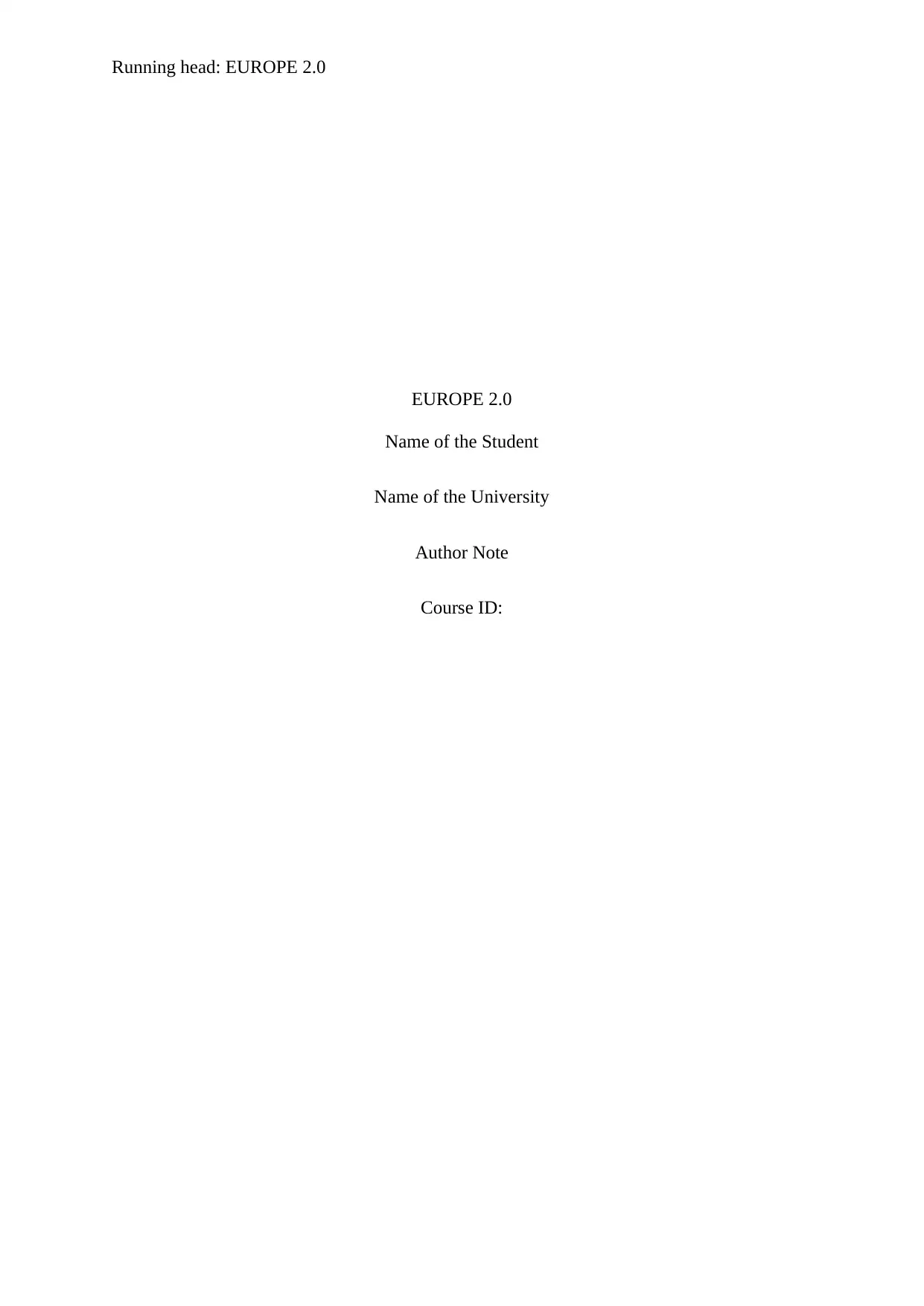
Running head: EUROPE 2.0
EUROPE 2.0
Name of the Student
Name of the University
Author Note
Course ID:
EUROPE 2.0
Name of the Student
Name of the University
Author Note
Course ID:
Paraphrase This Document
Need a fresh take? Get an instant paraphrase of this document with our AI Paraphraser
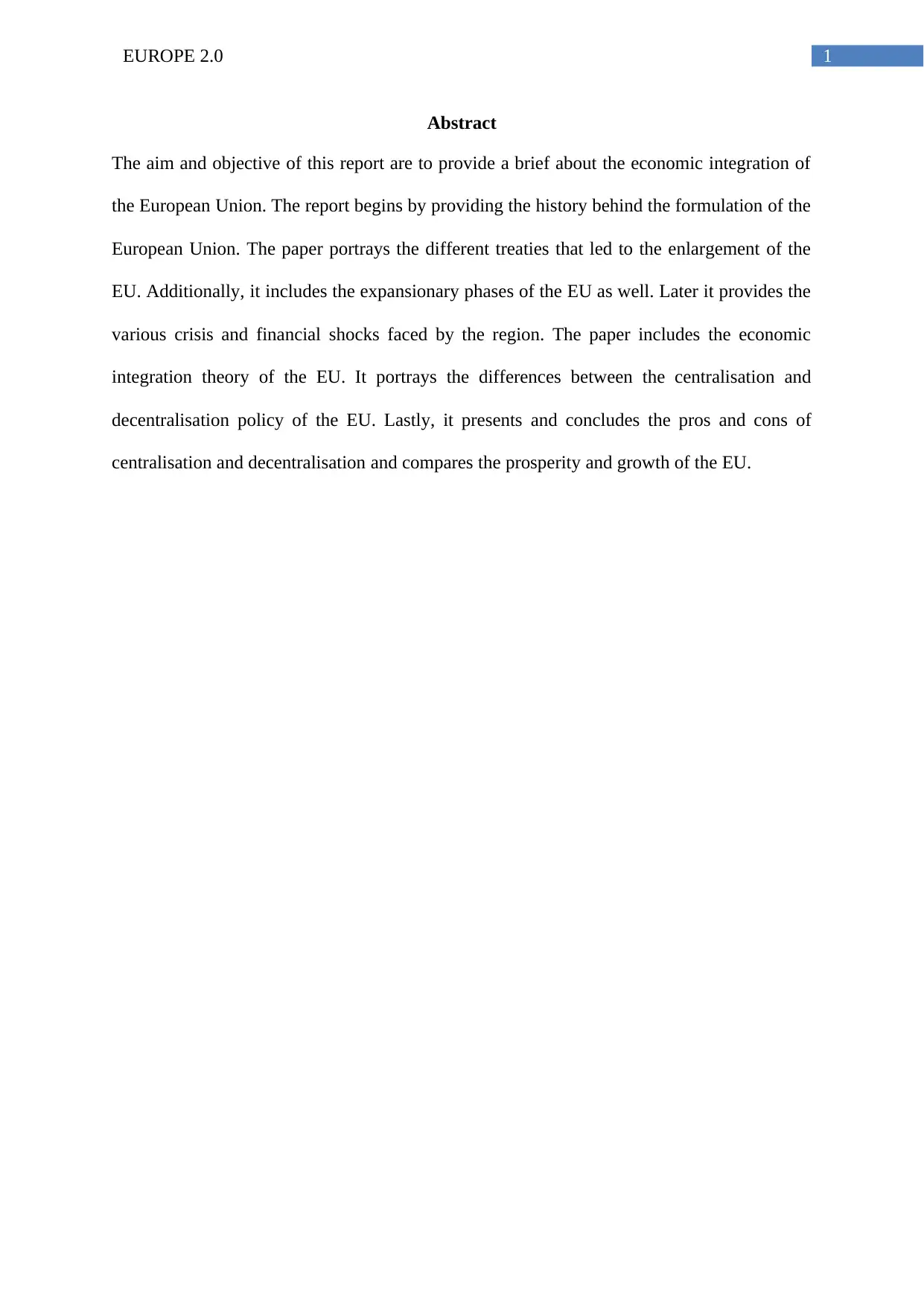
1EUROPE 2.0
Abstract
The aim and objective of this report are to provide a brief about the economic integration of
the European Union. The report begins by providing the history behind the formulation of the
European Union. The paper portrays the different treaties that led to the enlargement of the
EU. Additionally, it includes the expansionary phases of the EU as well. Later it provides the
various crisis and financial shocks faced by the region. The paper includes the economic
integration theory of the EU. It portrays the differences between the centralisation and
decentralisation policy of the EU. Lastly, it presents and concludes the pros and cons of
centralisation and decentralisation and compares the prosperity and growth of the EU.
Abstract
The aim and objective of this report are to provide a brief about the economic integration of
the European Union. The report begins by providing the history behind the formulation of the
European Union. The paper portrays the different treaties that led to the enlargement of the
EU. Additionally, it includes the expansionary phases of the EU as well. Later it provides the
various crisis and financial shocks faced by the region. The paper includes the economic
integration theory of the EU. It portrays the differences between the centralisation and
decentralisation policy of the EU. Lastly, it presents and concludes the pros and cons of
centralisation and decentralisation and compares the prosperity and growth of the EU.
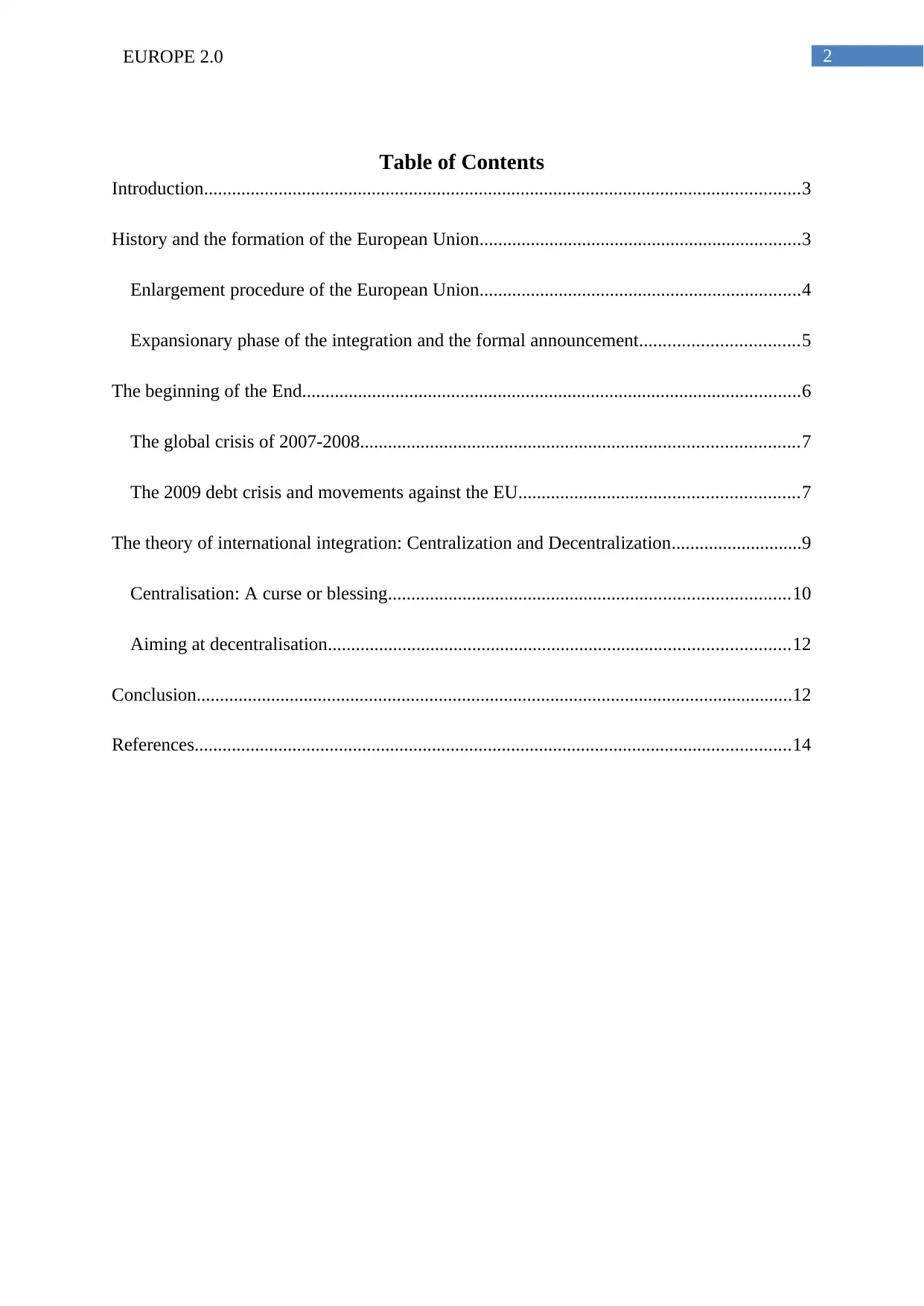
2EUROPE 2.0
Table of Contents
Introduction................................................................................................................................3
History and the formation of the European Union.....................................................................3
Enlargement procedure of the European Union.....................................................................4
Expansionary phase of the integration and the formal announcement..................................5
The beginning of the End...........................................................................................................6
The global crisis of 2007-2008..............................................................................................7
The 2009 debt crisis and movements against the EU............................................................7
The theory of international integration: Centralization and Decentralization............................9
Centralisation: A curse or blessing......................................................................................10
Aiming at decentralisation...................................................................................................12
Conclusion................................................................................................................................12
References................................................................................................................................14
Table of Contents
Introduction................................................................................................................................3
History and the formation of the European Union.....................................................................3
Enlargement procedure of the European Union.....................................................................4
Expansionary phase of the integration and the formal announcement..................................5
The beginning of the End...........................................................................................................6
The global crisis of 2007-2008..............................................................................................7
The 2009 debt crisis and movements against the EU............................................................7
The theory of international integration: Centralization and Decentralization............................9
Centralisation: A curse or blessing......................................................................................10
Aiming at decentralisation...................................................................................................12
Conclusion................................................................................................................................12
References................................................................................................................................14
⊘ This is a preview!⊘
Do you want full access?
Subscribe today to unlock all pages.

Trusted by 1+ million students worldwide
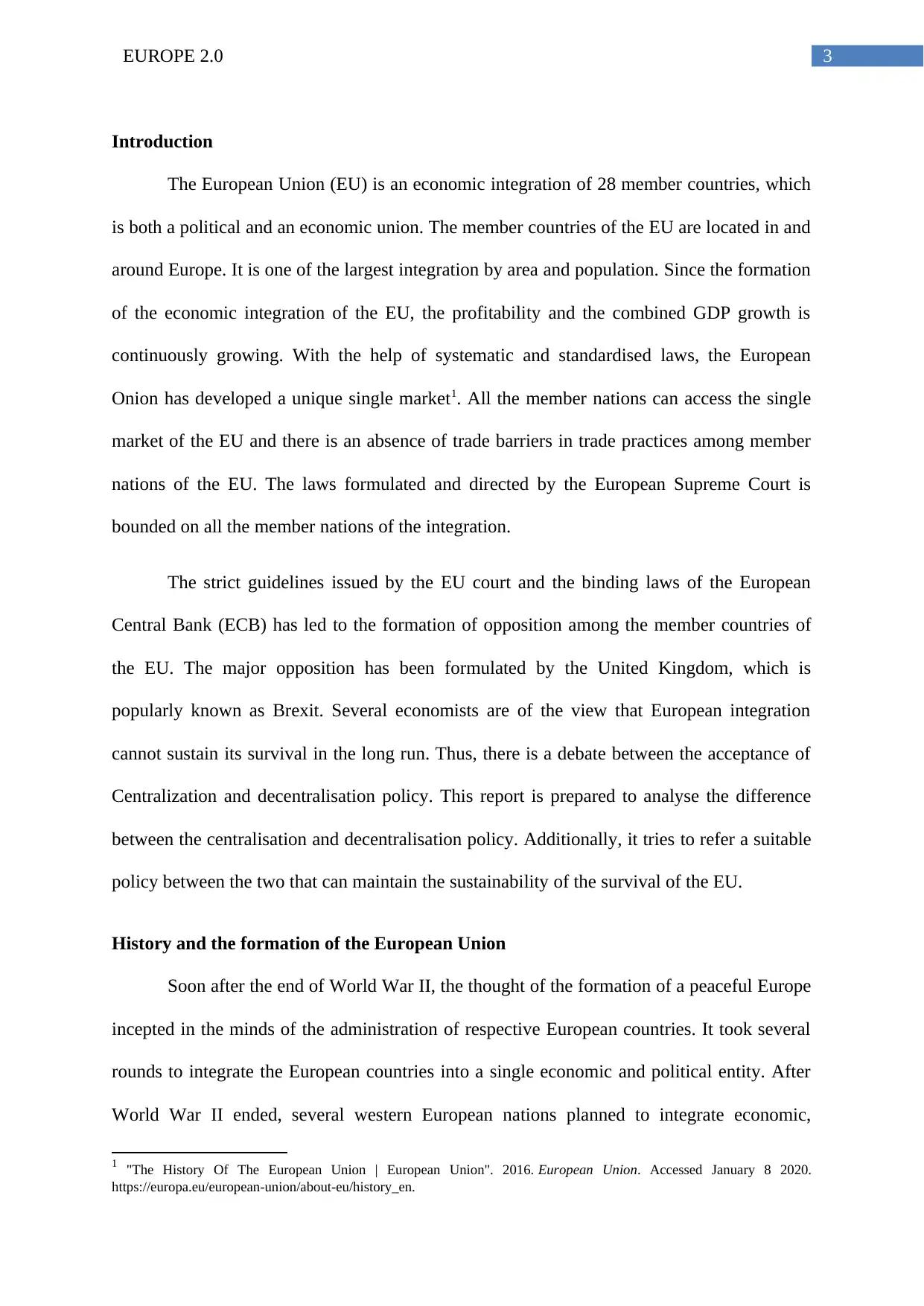
3EUROPE 2.0
Introduction
The European Union (EU) is an economic integration of 28 member countries, which
is both a political and an economic union. The member countries of the EU are located in and
around Europe. It is one of the largest integration by area and population. Since the formation
of the economic integration of the EU, the profitability and the combined GDP growth is
continuously growing. With the help of systematic and standardised laws, the European
Onion has developed a unique single market1. All the member nations can access the single
market of the EU and there is an absence of trade barriers in trade practices among member
nations of the EU. The laws formulated and directed by the European Supreme Court is
bounded on all the member nations of the integration.
The strict guidelines issued by the EU court and the binding laws of the European
Central Bank (ECB) has led to the formation of opposition among the member countries of
the EU. The major opposition has been formulated by the United Kingdom, which is
popularly known as Brexit. Several economists are of the view that European integration
cannot sustain its survival in the long run. Thus, there is a debate between the acceptance of
Centralization and decentralisation policy. This report is prepared to analyse the difference
between the centralisation and decentralisation policy. Additionally, it tries to refer a suitable
policy between the two that can maintain the sustainability of the survival of the EU.
History and the formation of the European Union
Soon after the end of World War II, the thought of the formation of a peaceful Europe
incepted in the minds of the administration of respective European countries. It took several
rounds to integrate the European countries into a single economic and political entity. After
World War II ended, several western European nations planned to integrate economic,
1 "The History Of The European Union | European Union". 2016. European Union. Accessed January 8 2020.
https://europa.eu/european-union/about-eu/history_en.
Introduction
The European Union (EU) is an economic integration of 28 member countries, which
is both a political and an economic union. The member countries of the EU are located in and
around Europe. It is one of the largest integration by area and population. Since the formation
of the economic integration of the EU, the profitability and the combined GDP growth is
continuously growing. With the help of systematic and standardised laws, the European
Onion has developed a unique single market1. All the member nations can access the single
market of the EU and there is an absence of trade barriers in trade practices among member
nations of the EU. The laws formulated and directed by the European Supreme Court is
bounded on all the member nations of the integration.
The strict guidelines issued by the EU court and the binding laws of the European
Central Bank (ECB) has led to the formation of opposition among the member countries of
the EU. The major opposition has been formulated by the United Kingdom, which is
popularly known as Brexit. Several economists are of the view that European integration
cannot sustain its survival in the long run. Thus, there is a debate between the acceptance of
Centralization and decentralisation policy. This report is prepared to analyse the difference
between the centralisation and decentralisation policy. Additionally, it tries to refer a suitable
policy between the two that can maintain the sustainability of the survival of the EU.
History and the formation of the European Union
Soon after the end of World War II, the thought of the formation of a peaceful Europe
incepted in the minds of the administration of respective European countries. It took several
rounds to integrate the European countries into a single economic and political entity. After
World War II ended, several western European nations planned to integrate economic,
1 "The History Of The European Union | European Union". 2016. European Union. Accessed January 8 2020.
https://europa.eu/european-union/about-eu/history_en.
Paraphrase This Document
Need a fresh take? Get an instant paraphrase of this document with our AI Paraphraser
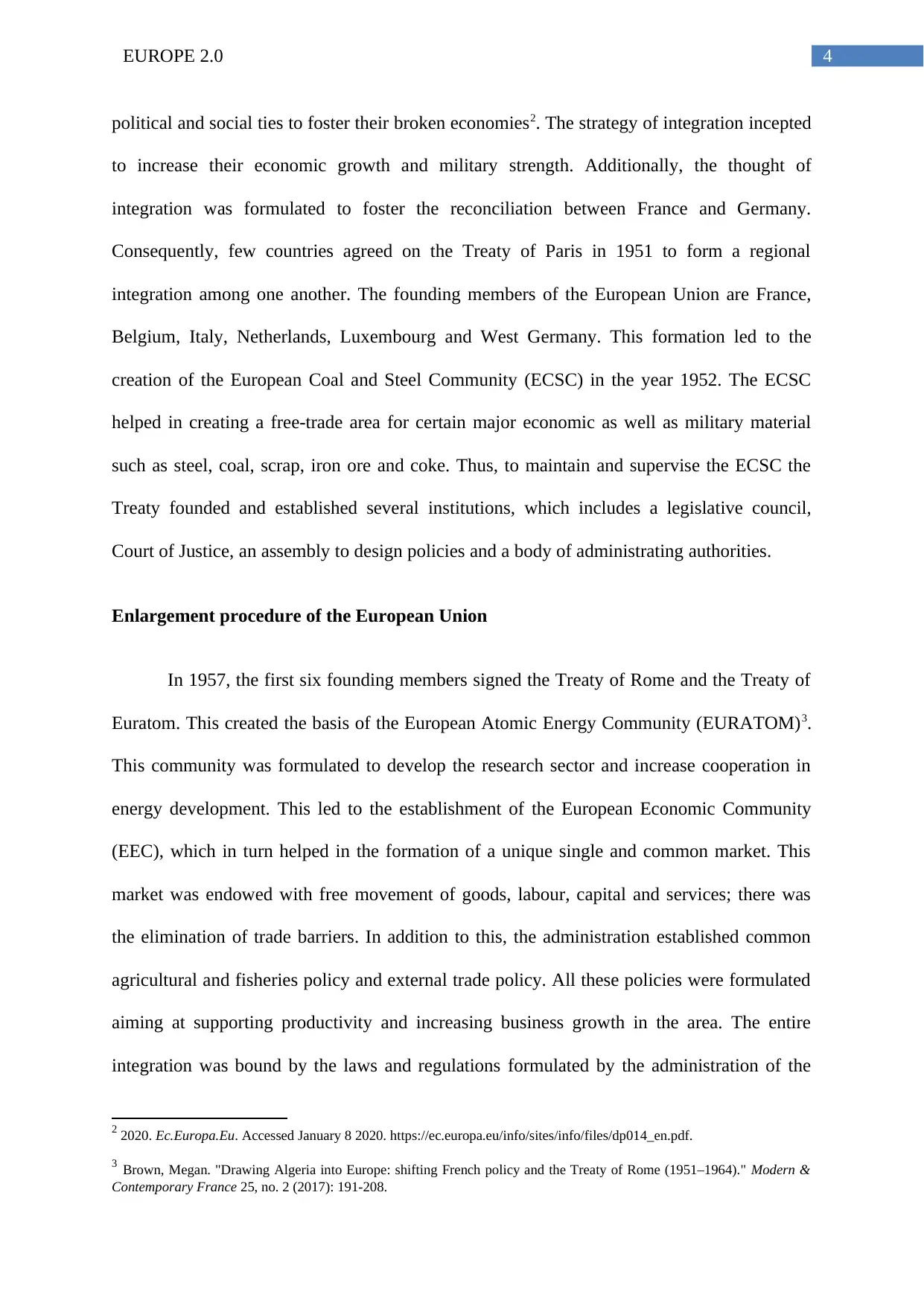
4EUROPE 2.0
political and social ties to foster their broken economies2. The strategy of integration incepted
to increase their economic growth and military strength. Additionally, the thought of
integration was formulated to foster the reconciliation between France and Germany.
Consequently, few countries agreed on the Treaty of Paris in 1951 to form a regional
integration among one another. The founding members of the European Union are France,
Belgium, Italy, Netherlands, Luxembourg and West Germany. This formation led to the
creation of the European Coal and Steel Community (ECSC) in the year 1952. The ECSC
helped in creating a free-trade area for certain major economic as well as military material
such as steel, coal, scrap, iron ore and coke. Thus, to maintain and supervise the ECSC the
Treaty founded and established several institutions, which includes a legislative council,
Court of Justice, an assembly to design policies and a body of administrating authorities.
Enlargement procedure of the European Union
In 1957, the first six founding members signed the Treaty of Rome and the Treaty of
Euratom. This created the basis of the European Atomic Energy Community (EURATOM)3.
This community was formulated to develop the research sector and increase cooperation in
energy development. This led to the establishment of the European Economic Community
(EEC), which in turn helped in the formation of a unique single and common market. This
market was endowed with free movement of goods, labour, capital and services; there was
the elimination of trade barriers. In addition to this, the administration established common
agricultural and fisheries policy and external trade policy. All these policies were formulated
aiming at supporting productivity and increasing business growth in the area. The entire
integration was bound by the laws and regulations formulated by the administration of the
2 2020. Ec.Europa.Eu. Accessed January 8 2020. https://ec.europa.eu/info/sites/info/files/dp014_en.pdf.
3 Brown, Megan. "Drawing Algeria into Europe: shifting French policy and the Treaty of Rome (1951–1964)." Modern &
Contemporary France 25, no. 2 (2017): 191-208.
political and social ties to foster their broken economies2. The strategy of integration incepted
to increase their economic growth and military strength. Additionally, the thought of
integration was formulated to foster the reconciliation between France and Germany.
Consequently, few countries agreed on the Treaty of Paris in 1951 to form a regional
integration among one another. The founding members of the European Union are France,
Belgium, Italy, Netherlands, Luxembourg and West Germany. This formation led to the
creation of the European Coal and Steel Community (ECSC) in the year 1952. The ECSC
helped in creating a free-trade area for certain major economic as well as military material
such as steel, coal, scrap, iron ore and coke. Thus, to maintain and supervise the ECSC the
Treaty founded and established several institutions, which includes a legislative council,
Court of Justice, an assembly to design policies and a body of administrating authorities.
Enlargement procedure of the European Union
In 1957, the first six founding members signed the Treaty of Rome and the Treaty of
Euratom. This created the basis of the European Atomic Energy Community (EURATOM)3.
This community was formulated to develop the research sector and increase cooperation in
energy development. This led to the establishment of the European Economic Community
(EEC), which in turn helped in the formation of a unique single and common market. This
market was endowed with free movement of goods, labour, capital and services; there was
the elimination of trade barriers. In addition to this, the administration established common
agricultural and fisheries policy and external trade policy. All these policies were formulated
aiming at supporting productivity and increasing business growth in the area. The entire
integration was bound by the laws and regulations formulated by the administration of the
2 2020. Ec.Europa.Eu. Accessed January 8 2020. https://ec.europa.eu/info/sites/info/files/dp014_en.pdf.
3 Brown, Megan. "Drawing Algeria into Europe: shifting French policy and the Treaty of Rome (1951–1964)." Modern &
Contemporary France 25, no. 2 (2017): 191-208.
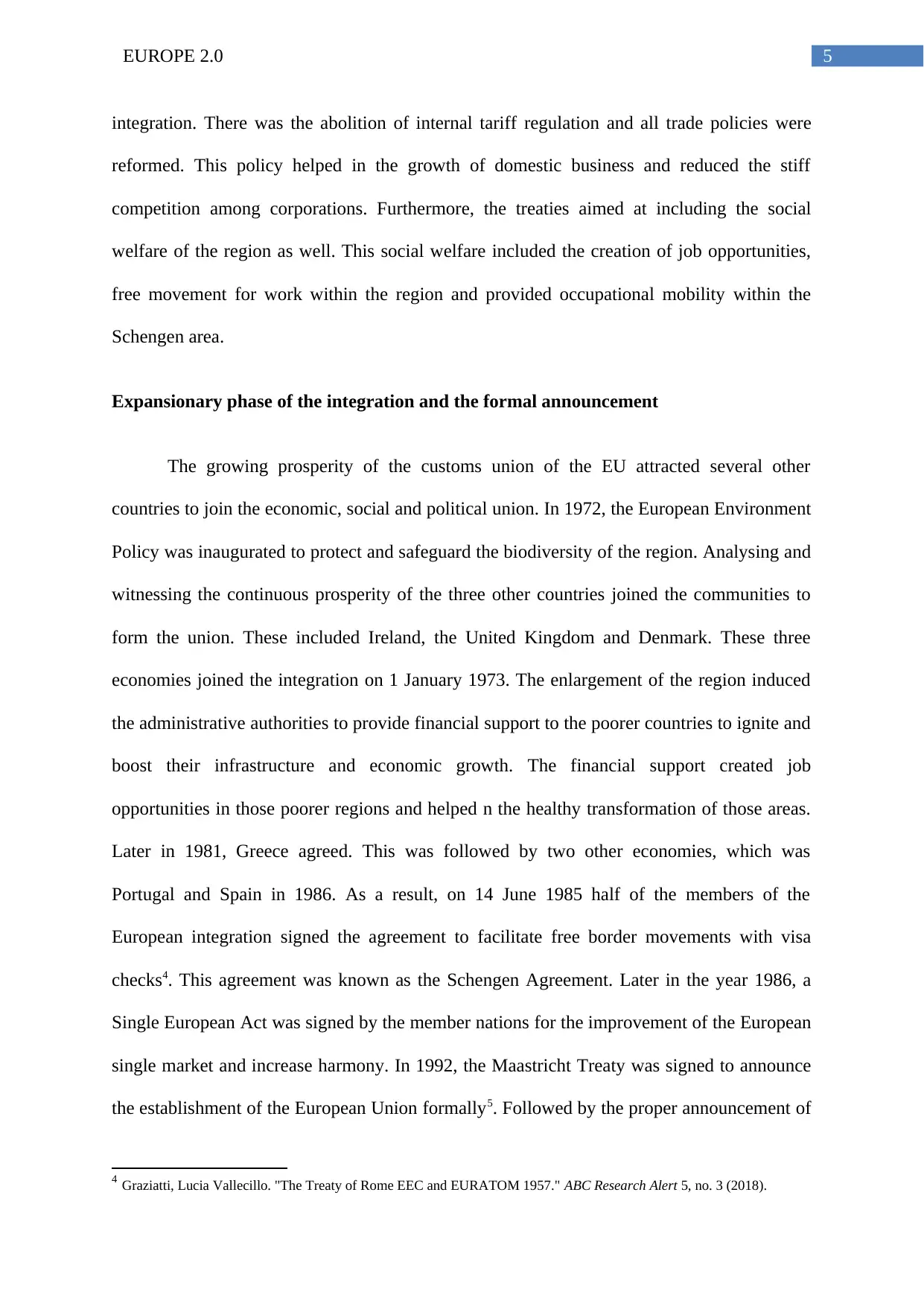
5EUROPE 2.0
integration. There was the abolition of internal tariff regulation and all trade policies were
reformed. This policy helped in the growth of domestic business and reduced the stiff
competition among corporations. Furthermore, the treaties aimed at including the social
welfare of the region as well. This social welfare included the creation of job opportunities,
free movement for work within the region and provided occupational mobility within the
Schengen area.
Expansionary phase of the integration and the formal announcement
The growing prosperity of the customs union of the EU attracted several other
countries to join the economic, social and political union. In 1972, the European Environment
Policy was inaugurated to protect and safeguard the biodiversity of the region. Analysing and
witnessing the continuous prosperity of the three other countries joined the communities to
form the union. These included Ireland, the United Kingdom and Denmark. These three
economies joined the integration on 1 January 1973. The enlargement of the region induced
the administrative authorities to provide financial support to the poorer countries to ignite and
boost their infrastructure and economic growth. The financial support created job
opportunities in those poorer regions and helped n the healthy transformation of those areas.
Later in 1981, Greece agreed. This was followed by two other economies, which was
Portugal and Spain in 1986. As a result, on 14 June 1985 half of the members of the
European integration signed the agreement to facilitate free border movements with visa
checks4. This agreement was known as the Schengen Agreement. Later in the year 1986, a
Single European Act was signed by the member nations for the improvement of the European
single market and increase harmony. In 1992, the Maastricht Treaty was signed to announce
the establishment of the European Union formally5. Followed by the proper announcement of
4 Graziatti, Lucia Vallecillo. "The Treaty of Rome EEC and EURATOM 1957." ABC Research Alert 5, no. 3 (2018).
integration. There was the abolition of internal tariff regulation and all trade policies were
reformed. This policy helped in the growth of domestic business and reduced the stiff
competition among corporations. Furthermore, the treaties aimed at including the social
welfare of the region as well. This social welfare included the creation of job opportunities,
free movement for work within the region and provided occupational mobility within the
Schengen area.
Expansionary phase of the integration and the formal announcement
The growing prosperity of the customs union of the EU attracted several other
countries to join the economic, social and political union. In 1972, the European Environment
Policy was inaugurated to protect and safeguard the biodiversity of the region. Analysing and
witnessing the continuous prosperity of the three other countries joined the communities to
form the union. These included Ireland, the United Kingdom and Denmark. These three
economies joined the integration on 1 January 1973. The enlargement of the region induced
the administrative authorities to provide financial support to the poorer countries to ignite and
boost their infrastructure and economic growth. The financial support created job
opportunities in those poorer regions and helped n the healthy transformation of those areas.
Later in 1981, Greece agreed. This was followed by two other economies, which was
Portugal and Spain in 1986. As a result, on 14 June 1985 half of the members of the
European integration signed the agreement to facilitate free border movements with visa
checks4. This agreement was known as the Schengen Agreement. Later in the year 1986, a
Single European Act was signed by the member nations for the improvement of the European
single market and increase harmony. In 1992, the Maastricht Treaty was signed to announce
the establishment of the European Union formally5. Followed by the proper announcement of
4 Graziatti, Lucia Vallecillo. "The Treaty of Rome EEC and EURATOM 1957." ABC Research Alert 5, no. 3 (2018).
⊘ This is a preview!⊘
Do you want full access?
Subscribe today to unlock all pages.

Trusted by 1+ million students worldwide
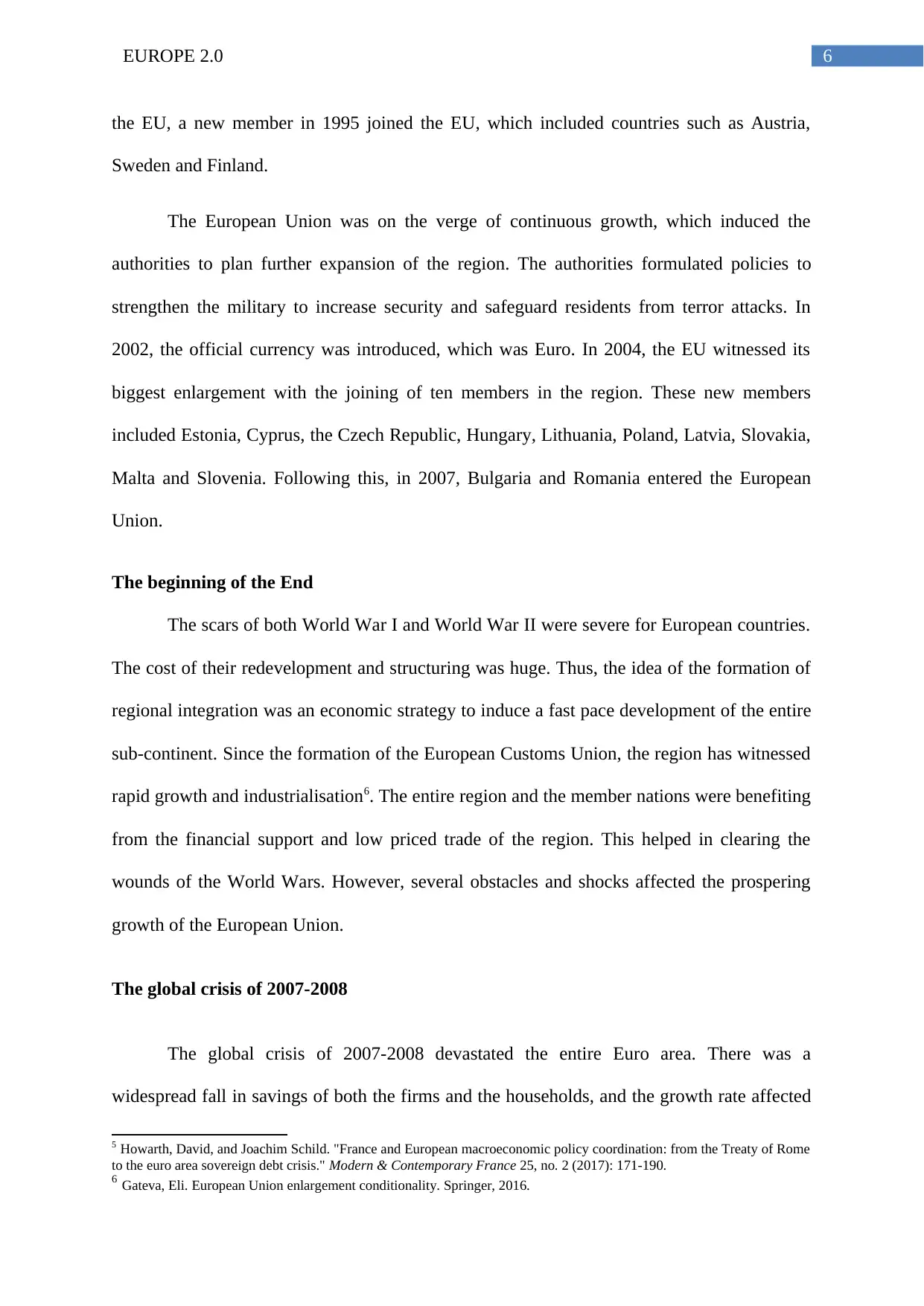
6EUROPE 2.0
the EU, a new member in 1995 joined the EU, which included countries such as Austria,
Sweden and Finland.
The European Union was on the verge of continuous growth, which induced the
authorities to plan further expansion of the region. The authorities formulated policies to
strengthen the military to increase security and safeguard residents from terror attacks. In
2002, the official currency was introduced, which was Euro. In 2004, the EU witnessed its
biggest enlargement with the joining of ten members in the region. These new members
included Estonia, Cyprus, the Czech Republic, Hungary, Lithuania, Poland, Latvia, Slovakia,
Malta and Slovenia. Following this, in 2007, Bulgaria and Romania entered the European
Union.
The beginning of the End
The scars of both World War I and World War II were severe for European countries.
The cost of their redevelopment and structuring was huge. Thus, the idea of the formation of
regional integration was an economic strategy to induce a fast pace development of the entire
sub-continent. Since the formation of the European Customs Union, the region has witnessed
rapid growth and industrialisation6. The entire region and the member nations were benefiting
from the financial support and low priced trade of the region. This helped in clearing the
wounds of the World Wars. However, several obstacles and shocks affected the prospering
growth of the European Union.
The global crisis of 2007-2008
The global crisis of 2007-2008 devastated the entire Euro area. There was a
widespread fall in savings of both the firms and the households, and the growth rate affected
5 Howarth, David, and Joachim Schild. "France and European macroeconomic policy coordination: from the Treaty of Rome
to the euro area sovereign debt crisis." Modern & Contemporary France 25, no. 2 (2017): 171-190.
6 Gateva, Eli. European Union enlargement conditionality. Springer, 2016.
the EU, a new member in 1995 joined the EU, which included countries such as Austria,
Sweden and Finland.
The European Union was on the verge of continuous growth, which induced the
authorities to plan further expansion of the region. The authorities formulated policies to
strengthen the military to increase security and safeguard residents from terror attacks. In
2002, the official currency was introduced, which was Euro. In 2004, the EU witnessed its
biggest enlargement with the joining of ten members in the region. These new members
included Estonia, Cyprus, the Czech Republic, Hungary, Lithuania, Poland, Latvia, Slovakia,
Malta and Slovenia. Following this, in 2007, Bulgaria and Romania entered the European
Union.
The beginning of the End
The scars of both World War I and World War II were severe for European countries.
The cost of their redevelopment and structuring was huge. Thus, the idea of the formation of
regional integration was an economic strategy to induce a fast pace development of the entire
sub-continent. Since the formation of the European Customs Union, the region has witnessed
rapid growth and industrialisation6. The entire region and the member nations were benefiting
from the financial support and low priced trade of the region. This helped in clearing the
wounds of the World Wars. However, several obstacles and shocks affected the prospering
growth of the European Union.
The global crisis of 2007-2008
The global crisis of 2007-2008 devastated the entire Euro area. There was a
widespread fall in savings of both the firms and the households, and the growth rate affected
5 Howarth, David, and Joachim Schild. "France and European macroeconomic policy coordination: from the Treaty of Rome
to the euro area sovereign debt crisis." Modern & Contemporary France 25, no. 2 (2017): 171-190.
6 Gateva, Eli. European Union enlargement conditionality. Springer, 2016.
Paraphrase This Document
Need a fresh take? Get an instant paraphrase of this document with our AI Paraphraser
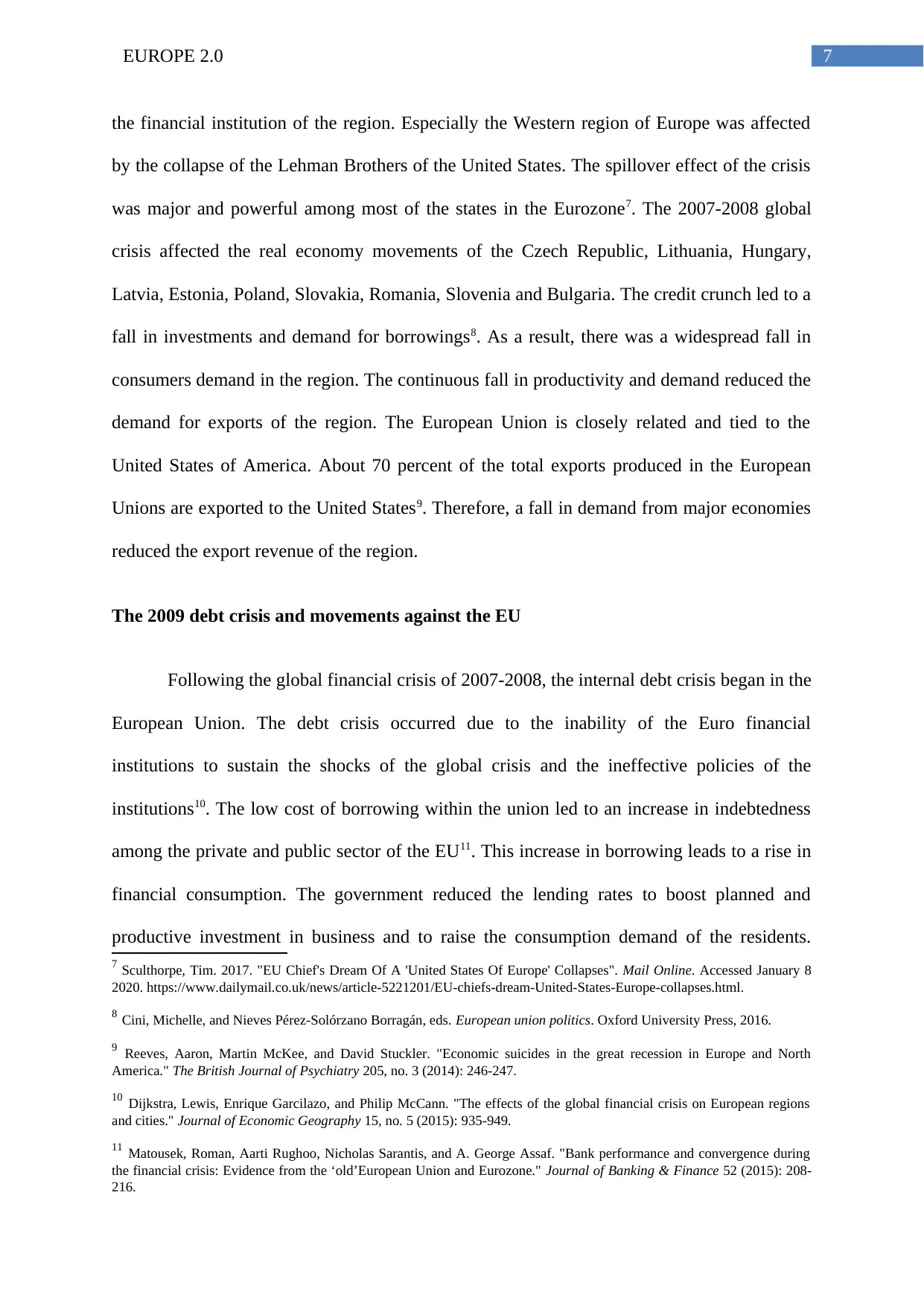
7EUROPE 2.0
the financial institution of the region. Especially the Western region of Europe was affected
by the collapse of the Lehman Brothers of the United States. The spillover effect of the crisis
was major and powerful among most of the states in the Eurozone7. The 2007-2008 global
crisis affected the real economy movements of the Czech Republic, Lithuania, Hungary,
Latvia, Estonia, Poland, Slovakia, Romania, Slovenia and Bulgaria. The credit crunch led to a
fall in investments and demand for borrowings8. As a result, there was a widespread fall in
consumers demand in the region. The continuous fall in productivity and demand reduced the
demand for exports of the region. The European Union is closely related and tied to the
United States of America. About 70 percent of the total exports produced in the European
Unions are exported to the United States9. Therefore, a fall in demand from major economies
reduced the export revenue of the region.
The 2009 debt crisis and movements against the EU
Following the global financial crisis of 2007-2008, the internal debt crisis began in the
European Union. The debt crisis occurred due to the inability of the Euro financial
institutions to sustain the shocks of the global crisis and the ineffective policies of the
institutions10. The low cost of borrowing within the union led to an increase in indebtedness
among the private and public sector of the EU11. This increase in borrowing leads to a rise in
financial consumption. The government reduced the lending rates to boost planned and
productive investment in business and to raise the consumption demand of the residents.
7 Sculthorpe, Tim. 2017. "EU Chief's Dream Of A 'United States Of Europe' Collapses". Mail Online. Accessed January 8
2020. https://www.dailymail.co.uk/news/article-5221201/EU-chiefs-dream-United-States-Europe-collapses.html.
8 Cini, Michelle, and Nieves Pérez-Solórzano Borragán, eds. European union politics. Oxford University Press, 2016.
9 Reeves, Aaron, Martin McKee, and David Stuckler. "Economic suicides in the great recession in Europe and North
America." The British Journal of Psychiatry 205, no. 3 (2014): 246-247.
10 Dijkstra, Lewis, Enrique Garcilazo, and Philip McCann. "The effects of the global financial crisis on European regions
and cities." Journal of Economic Geography 15, no. 5 (2015): 935-949.
11 Matousek, Roman, Aarti Rughoo, Nicholas Sarantis, and A. George Assaf. "Bank performance and convergence during
the financial crisis: Evidence from the ‘old’European Union and Eurozone." Journal of Banking & Finance 52 (2015): 208-
216.
the financial institution of the region. Especially the Western region of Europe was affected
by the collapse of the Lehman Brothers of the United States. The spillover effect of the crisis
was major and powerful among most of the states in the Eurozone7. The 2007-2008 global
crisis affected the real economy movements of the Czech Republic, Lithuania, Hungary,
Latvia, Estonia, Poland, Slovakia, Romania, Slovenia and Bulgaria. The credit crunch led to a
fall in investments and demand for borrowings8. As a result, there was a widespread fall in
consumers demand in the region. The continuous fall in productivity and demand reduced the
demand for exports of the region. The European Union is closely related and tied to the
United States of America. About 70 percent of the total exports produced in the European
Unions are exported to the United States9. Therefore, a fall in demand from major economies
reduced the export revenue of the region.
The 2009 debt crisis and movements against the EU
Following the global financial crisis of 2007-2008, the internal debt crisis began in the
European Union. The debt crisis occurred due to the inability of the Euro financial
institutions to sustain the shocks of the global crisis and the ineffective policies of the
institutions10. The low cost of borrowing within the union led to an increase in indebtedness
among the private and public sector of the EU11. This increase in borrowing leads to a rise in
financial consumption. The government reduced the lending rates to boost planned and
productive investment in business and to raise the consumption demand of the residents.
7 Sculthorpe, Tim. 2017. "EU Chief's Dream Of A 'United States Of Europe' Collapses". Mail Online. Accessed January 8
2020. https://www.dailymail.co.uk/news/article-5221201/EU-chiefs-dream-United-States-Europe-collapses.html.
8 Cini, Michelle, and Nieves Pérez-Solórzano Borragán, eds. European union politics. Oxford University Press, 2016.
9 Reeves, Aaron, Martin McKee, and David Stuckler. "Economic suicides in the great recession in Europe and North
America." The British Journal of Psychiatry 205, no. 3 (2014): 246-247.
10 Dijkstra, Lewis, Enrique Garcilazo, and Philip McCann. "The effects of the global financial crisis on European regions
and cities." Journal of Economic Geography 15, no. 5 (2015): 935-949.
11 Matousek, Roman, Aarti Rughoo, Nicholas Sarantis, and A. George Assaf. "Bank performance and convergence during
the financial crisis: Evidence from the ‘old’European Union and Eurozone." Journal of Banking & Finance 52 (2015): 208-
216.
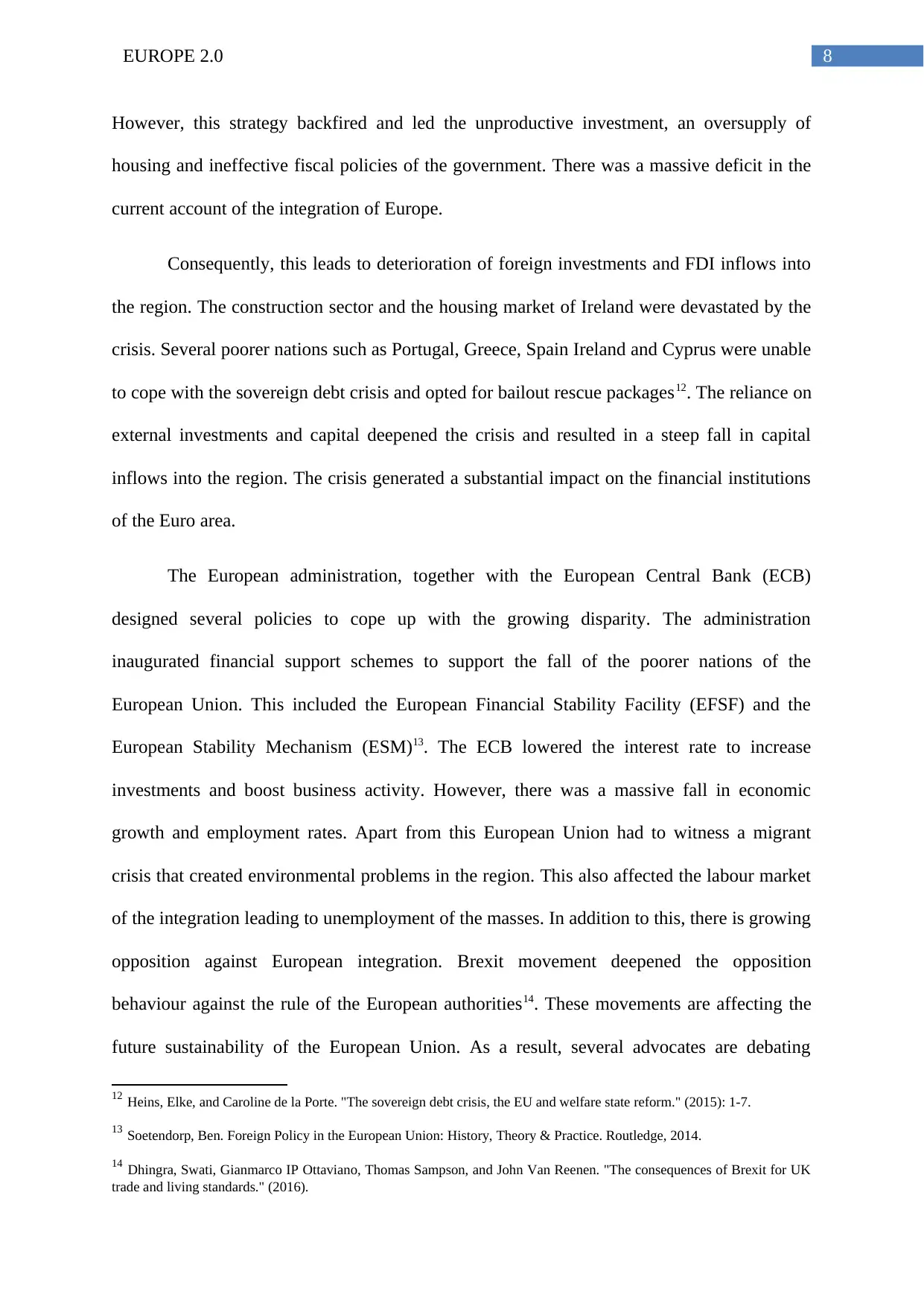
8EUROPE 2.0
However, this strategy backfired and led the unproductive investment, an oversupply of
housing and ineffective fiscal policies of the government. There was a massive deficit in the
current account of the integration of Europe.
Consequently, this leads to deterioration of foreign investments and FDI inflows into
the region. The construction sector and the housing market of Ireland were devastated by the
crisis. Several poorer nations such as Portugal, Greece, Spain Ireland and Cyprus were unable
to cope with the sovereign debt crisis and opted for bailout rescue packages12. The reliance on
external investments and capital deepened the crisis and resulted in a steep fall in capital
inflows into the region. The crisis generated a substantial impact on the financial institutions
of the Euro area.
The European administration, together with the European Central Bank (ECB)
designed several policies to cope up with the growing disparity. The administration
inaugurated financial support schemes to support the fall of the poorer nations of the
European Union. This included the European Financial Stability Facility (EFSF) and the
European Stability Mechanism (ESM)13. The ECB lowered the interest rate to increase
investments and boost business activity. However, there was a massive fall in economic
growth and employment rates. Apart from this European Union had to witness a migrant
crisis that created environmental problems in the region. This also affected the labour market
of the integration leading to unemployment of the masses. In addition to this, there is growing
opposition against European integration. Brexit movement deepened the opposition
behaviour against the rule of the European authorities14. These movements are affecting the
future sustainability of the European Union. As a result, several advocates are debating
12 Heins, Elke, and Caroline de la Porte. "The sovereign debt crisis, the EU and welfare state reform." (2015): 1-7.
13 Soetendorp, Ben. Foreign Policy in the European Union: History, Theory & Practice. Routledge, 2014.
14 Dhingra, Swati, Gianmarco IP Ottaviano, Thomas Sampson, and John Van Reenen. "The consequences of Brexit for UK
trade and living standards." (2016).
However, this strategy backfired and led the unproductive investment, an oversupply of
housing and ineffective fiscal policies of the government. There was a massive deficit in the
current account of the integration of Europe.
Consequently, this leads to deterioration of foreign investments and FDI inflows into
the region. The construction sector and the housing market of Ireland were devastated by the
crisis. Several poorer nations such as Portugal, Greece, Spain Ireland and Cyprus were unable
to cope with the sovereign debt crisis and opted for bailout rescue packages12. The reliance on
external investments and capital deepened the crisis and resulted in a steep fall in capital
inflows into the region. The crisis generated a substantial impact on the financial institutions
of the Euro area.
The European administration, together with the European Central Bank (ECB)
designed several policies to cope up with the growing disparity. The administration
inaugurated financial support schemes to support the fall of the poorer nations of the
European Union. This included the European Financial Stability Facility (EFSF) and the
European Stability Mechanism (ESM)13. The ECB lowered the interest rate to increase
investments and boost business activity. However, there was a massive fall in economic
growth and employment rates. Apart from this European Union had to witness a migrant
crisis that created environmental problems in the region. This also affected the labour market
of the integration leading to unemployment of the masses. In addition to this, there is growing
opposition against European integration. Brexit movement deepened the opposition
behaviour against the rule of the European authorities14. These movements are affecting the
future sustainability of the European Union. As a result, several advocates are debating
12 Heins, Elke, and Caroline de la Porte. "The sovereign debt crisis, the EU and welfare state reform." (2015): 1-7.
13 Soetendorp, Ben. Foreign Policy in the European Union: History, Theory & Practice. Routledge, 2014.
14 Dhingra, Swati, Gianmarco IP Ottaviano, Thomas Sampson, and John Van Reenen. "The consequences of Brexit for UK
trade and living standards." (2016).
⊘ This is a preview!⊘
Do you want full access?
Subscribe today to unlock all pages.

Trusted by 1+ million students worldwide
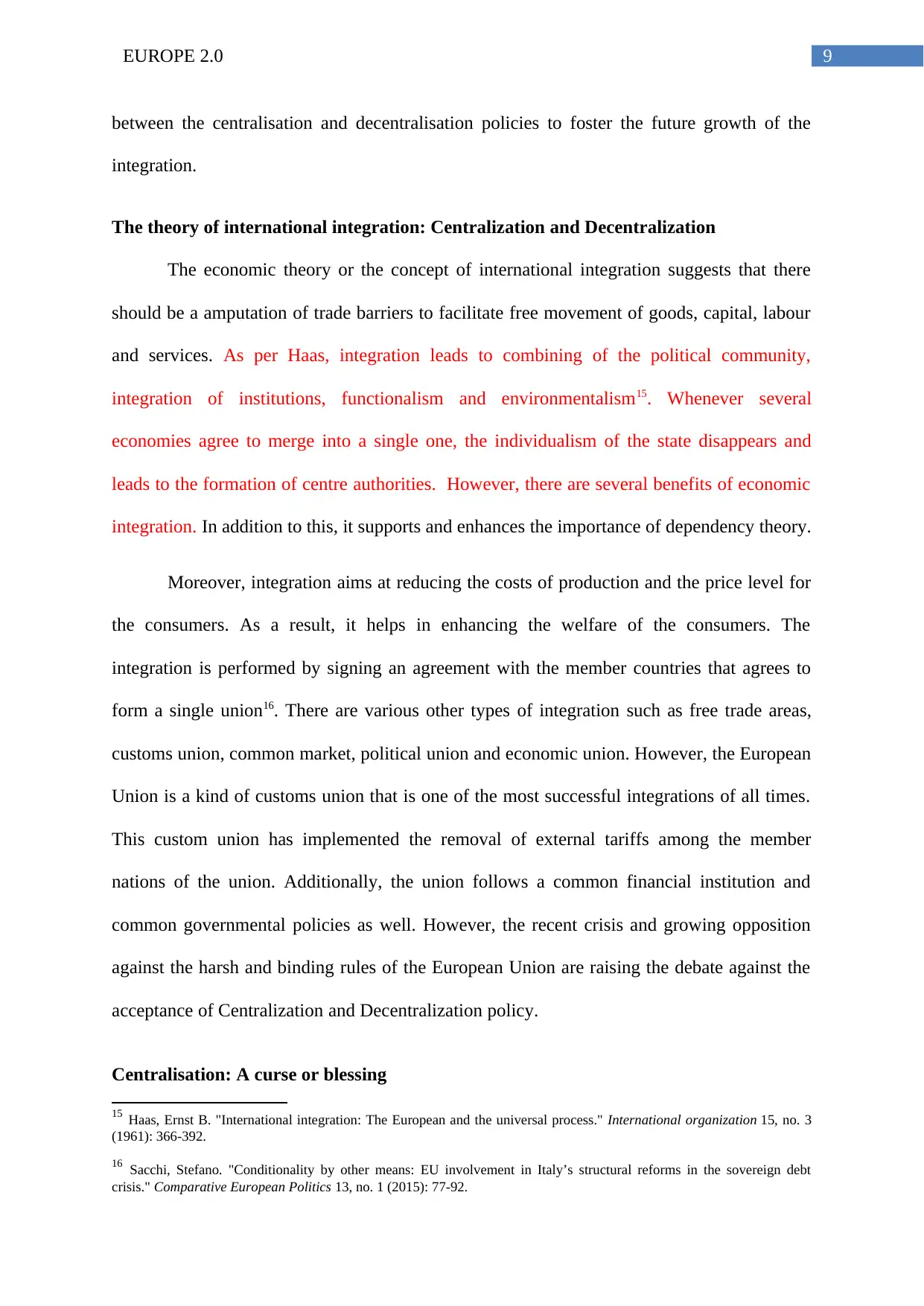
9EUROPE 2.0
between the centralisation and decentralisation policies to foster the future growth of the
integration.
The theory of international integration: Centralization and Decentralization
The economic theory or the concept of international integration suggests that there
should be a amputation of trade barriers to facilitate free movement of goods, capital, labour
and services. As per Haas, integration leads to combining of the political community,
integration of institutions, functionalism and environmentalism15. Whenever several
economies agree to merge into a single one, the individualism of the state disappears and
leads to the formation of centre authorities. However, there are several benefits of economic
integration. In addition to this, it supports and enhances the importance of dependency theory.
Moreover, integration aims at reducing the costs of production and the price level for
the consumers. As a result, it helps in enhancing the welfare of the consumers. The
integration is performed by signing an agreement with the member countries that agrees to
form a single union16. There are various other types of integration such as free trade areas,
customs union, common market, political union and economic union. However, the European
Union is a kind of customs union that is one of the most successful integrations of all times.
This custom union has implemented the removal of external tariffs among the member
nations of the union. Additionally, the union follows a common financial institution and
common governmental policies as well. However, the recent crisis and growing opposition
against the harsh and binding rules of the European Union are raising the debate against the
acceptance of Centralization and Decentralization policy.
Centralisation: A curse or blessing
15 Haas, Ernst B. "International integration: The European and the universal process." International organization 15, no. 3
(1961): 366-392.
16 Sacchi, Stefano. "Conditionality by other means: EU involvement in Italy’s structural reforms in the sovereign debt
crisis." Comparative European Politics 13, no. 1 (2015): 77-92.
between the centralisation and decentralisation policies to foster the future growth of the
integration.
The theory of international integration: Centralization and Decentralization
The economic theory or the concept of international integration suggests that there
should be a amputation of trade barriers to facilitate free movement of goods, capital, labour
and services. As per Haas, integration leads to combining of the political community,
integration of institutions, functionalism and environmentalism15. Whenever several
economies agree to merge into a single one, the individualism of the state disappears and
leads to the formation of centre authorities. However, there are several benefits of economic
integration. In addition to this, it supports and enhances the importance of dependency theory.
Moreover, integration aims at reducing the costs of production and the price level for
the consumers. As a result, it helps in enhancing the welfare of the consumers. The
integration is performed by signing an agreement with the member countries that agrees to
form a single union16. There are various other types of integration such as free trade areas,
customs union, common market, political union and economic union. However, the European
Union is a kind of customs union that is one of the most successful integrations of all times.
This custom union has implemented the removal of external tariffs among the member
nations of the union. Additionally, the union follows a common financial institution and
common governmental policies as well. However, the recent crisis and growing opposition
against the harsh and binding rules of the European Union are raising the debate against the
acceptance of Centralization and Decentralization policy.
Centralisation: A curse or blessing
15 Haas, Ernst B. "International integration: The European and the universal process." International organization 15, no. 3
(1961): 366-392.
16 Sacchi, Stefano. "Conditionality by other means: EU involvement in Italy’s structural reforms in the sovereign debt
crisis." Comparative European Politics 13, no. 1 (2015): 77-92.
Paraphrase This Document
Need a fresh take? Get an instant paraphrase of this document with our AI Paraphraser
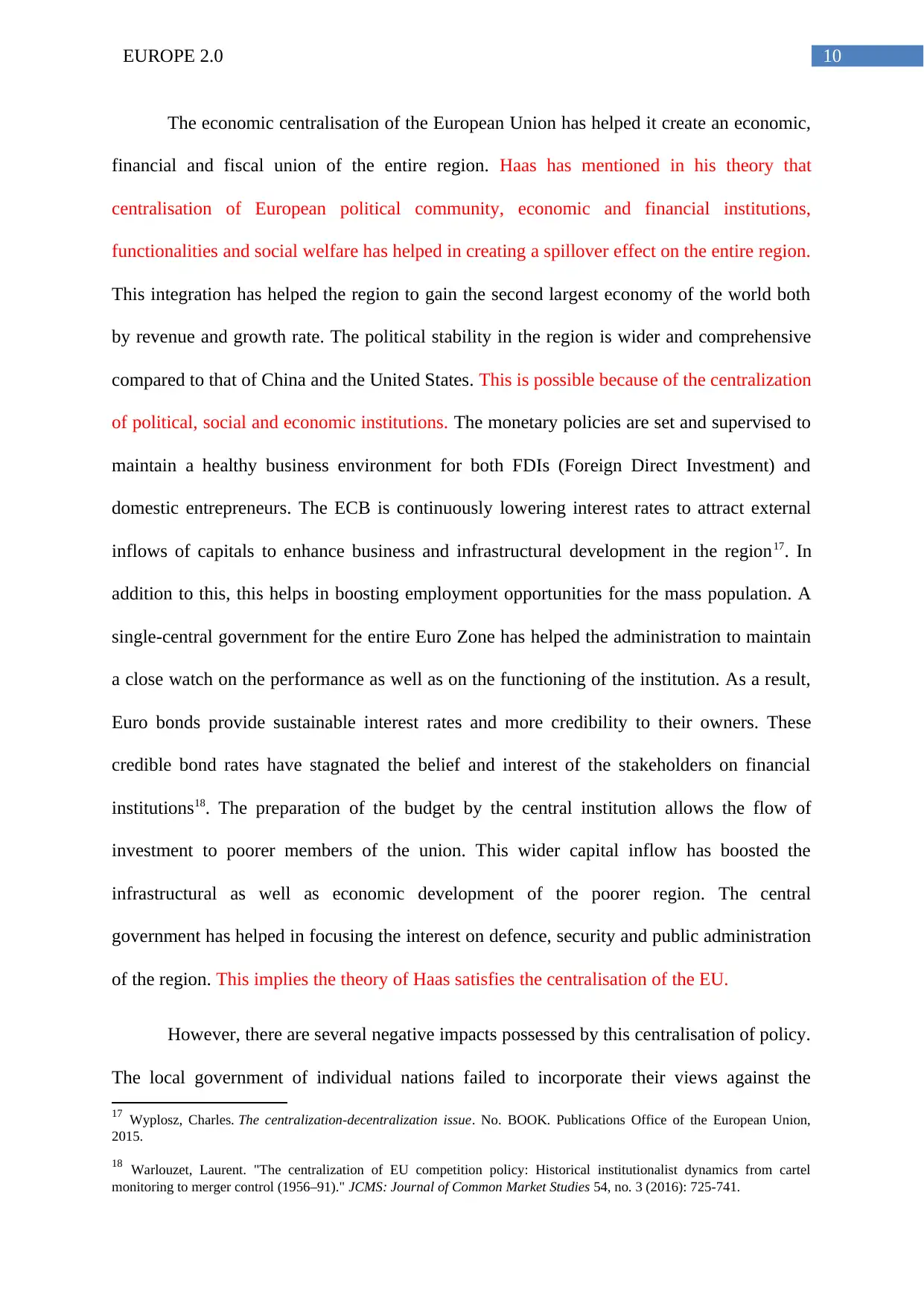
10EUROPE 2.0
The economic centralisation of the European Union has helped it create an economic,
financial and fiscal union of the entire region. Haas has mentioned in his theory that
centralisation of European political community, economic and financial institutions,
functionalities and social welfare has helped in creating a spillover effect on the entire region.
This integration has helped the region to gain the second largest economy of the world both
by revenue and growth rate. The political stability in the region is wider and comprehensive
compared to that of China and the United States. This is possible because of the centralization
of political, social and economic institutions. The monetary policies are set and supervised to
maintain a healthy business environment for both FDIs (Foreign Direct Investment) and
domestic entrepreneurs. The ECB is continuously lowering interest rates to attract external
inflows of capitals to enhance business and infrastructural development in the region17. In
addition to this, this helps in boosting employment opportunities for the mass population. A
single-central government for the entire Euro Zone has helped the administration to maintain
a close watch on the performance as well as on the functioning of the institution. As a result,
Euro bonds provide sustainable interest rates and more credibility to their owners. These
credible bond rates have stagnated the belief and interest of the stakeholders on financial
institutions18. The preparation of the budget by the central institution allows the flow of
investment to poorer members of the union. This wider capital inflow has boosted the
infrastructural as well as economic development of the poorer region. The central
government has helped in focusing the interest on defence, security and public administration
of the region. This implies the theory of Haas satisfies the centralisation of the EU.
However, there are several negative impacts possessed by this centralisation of policy.
The local government of individual nations failed to incorporate their views against the
17 Wyplosz, Charles. The centralization-decentralization issue. No. BOOK. Publications Office of the European Union,
2015.
18 Warlouzet, Laurent. "The centralization of EU competition policy: Historical institutionalist dynamics from cartel
monitoring to merger control (1956–91)." JCMS: Journal of Common Market Studies 54, no. 3 (2016): 725-741.
The economic centralisation of the European Union has helped it create an economic,
financial and fiscal union of the entire region. Haas has mentioned in his theory that
centralisation of European political community, economic and financial institutions,
functionalities and social welfare has helped in creating a spillover effect on the entire region.
This integration has helped the region to gain the second largest economy of the world both
by revenue and growth rate. The political stability in the region is wider and comprehensive
compared to that of China and the United States. This is possible because of the centralization
of political, social and economic institutions. The monetary policies are set and supervised to
maintain a healthy business environment for both FDIs (Foreign Direct Investment) and
domestic entrepreneurs. The ECB is continuously lowering interest rates to attract external
inflows of capitals to enhance business and infrastructural development in the region17. In
addition to this, this helps in boosting employment opportunities for the mass population. A
single-central government for the entire Euro Zone has helped the administration to maintain
a close watch on the performance as well as on the functioning of the institution. As a result,
Euro bonds provide sustainable interest rates and more credibility to their owners. These
credible bond rates have stagnated the belief and interest of the stakeholders on financial
institutions18. The preparation of the budget by the central institution allows the flow of
investment to poorer members of the union. This wider capital inflow has boosted the
infrastructural as well as economic development of the poorer region. The central
government has helped in focusing the interest on defence, security and public administration
of the region. This implies the theory of Haas satisfies the centralisation of the EU.
However, there are several negative impacts possessed by this centralisation of policy.
The local government of individual nations failed to incorporate their views against the
17 Wyplosz, Charles. The centralization-decentralization issue. No. BOOK. Publications Office of the European Union,
2015.
18 Warlouzet, Laurent. "The centralization of EU competition policy: Historical institutionalist dynamics from cartel
monitoring to merger control (1956–91)." JCMS: Journal of Common Market Studies 54, no. 3 (2016): 725-741.
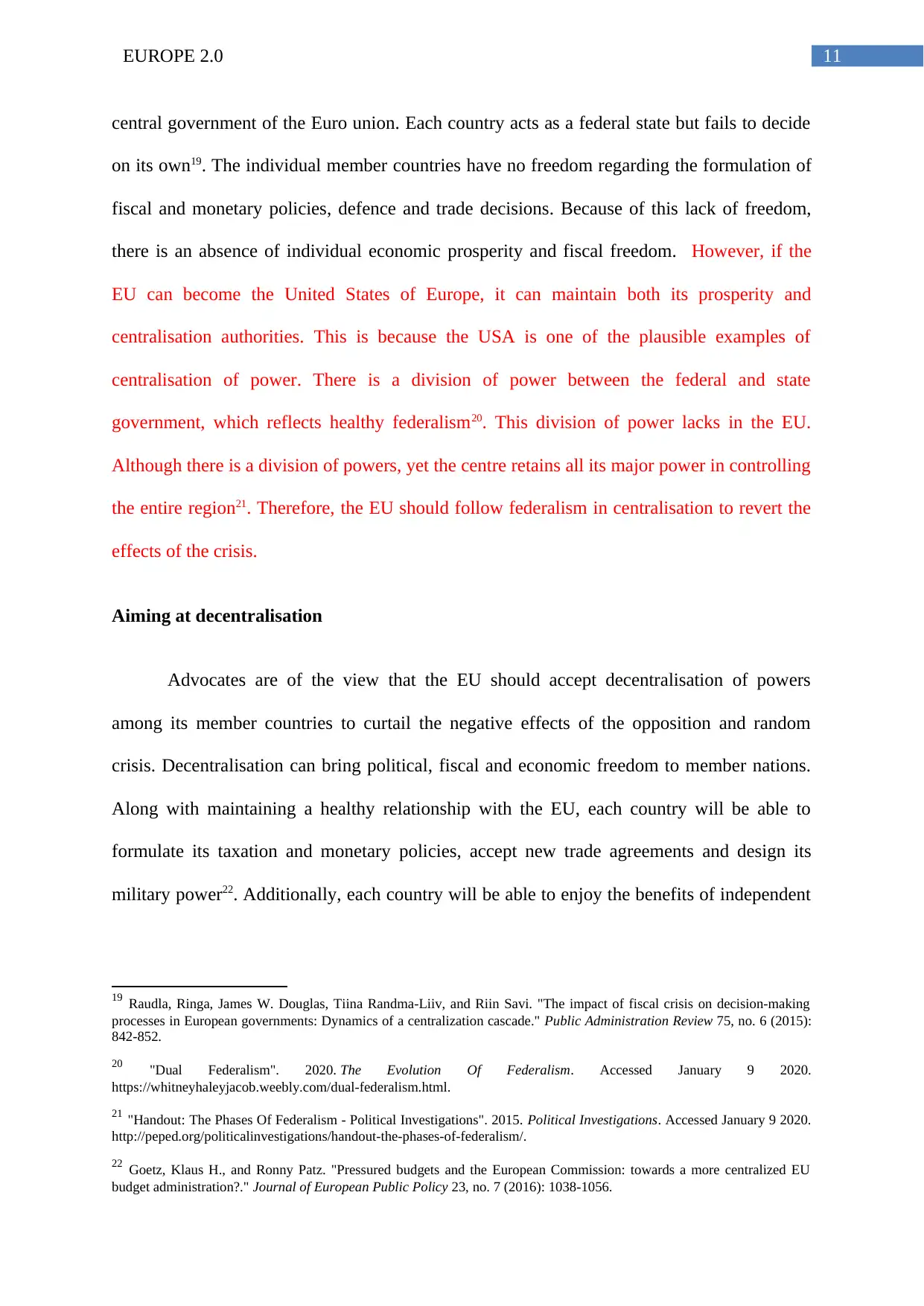
11EUROPE 2.0
central government of the Euro union. Each country acts as a federal state but fails to decide
on its own19. The individual member countries have no freedom regarding the formulation of
fiscal and monetary policies, defence and trade decisions. Because of this lack of freedom,
there is an absence of individual economic prosperity and fiscal freedom. However, if the
EU can become the United States of Europe, it can maintain both its prosperity and
centralisation authorities. This is because the USA is one of the plausible examples of
centralisation of power. There is a division of power between the federal and state
government, which reflects healthy federalism20. This division of power lacks in the EU.
Although there is a division of powers, yet the centre retains all its major power in controlling
the entire region21. Therefore, the EU should follow federalism in centralisation to revert the
effects of the crisis.
Aiming at decentralisation
Advocates are of the view that the EU should accept decentralisation of powers
among its member countries to curtail the negative effects of the opposition and random
crisis. Decentralisation can bring political, fiscal and economic freedom to member nations.
Along with maintaining a healthy relationship with the EU, each country will be able to
formulate its taxation and monetary policies, accept new trade agreements and design its
military power22. Additionally, each country will be able to enjoy the benefits of independent
19 Raudla, Ringa, James W. Douglas, Tiina Randma‐Liiv, and Riin Savi. "The impact of fiscal crisis on decision‐making
processes in European governments: Dynamics of a centralization cascade." Public Administration Review 75, no. 6 (2015):
842-852.
20 "Dual Federalism". 2020. The Evolution Of Federalism. Accessed January 9 2020.
https://whitneyhaleyjacob.weebly.com/dual-federalism.html.
21 "Handout: The Phases Of Federalism - Political Investigations". 2015. Political Investigations. Accessed January 9 2020.
http://peped.org/politicalinvestigations/handout-the-phases-of-federalism/.
22 Goetz, Klaus H., and Ronny Patz. "Pressured budgets and the European Commission: towards a more centralized EU
budget administration?." Journal of European Public Policy 23, no. 7 (2016): 1038-1056.
central government of the Euro union. Each country acts as a federal state but fails to decide
on its own19. The individual member countries have no freedom regarding the formulation of
fiscal and monetary policies, defence and trade decisions. Because of this lack of freedom,
there is an absence of individual economic prosperity and fiscal freedom. However, if the
EU can become the United States of Europe, it can maintain both its prosperity and
centralisation authorities. This is because the USA is one of the plausible examples of
centralisation of power. There is a division of power between the federal and state
government, which reflects healthy federalism20. This division of power lacks in the EU.
Although there is a division of powers, yet the centre retains all its major power in controlling
the entire region21. Therefore, the EU should follow federalism in centralisation to revert the
effects of the crisis.
Aiming at decentralisation
Advocates are of the view that the EU should accept decentralisation of powers
among its member countries to curtail the negative effects of the opposition and random
crisis. Decentralisation can bring political, fiscal and economic freedom to member nations.
Along with maintaining a healthy relationship with the EU, each country will be able to
formulate its taxation and monetary policies, accept new trade agreements and design its
military power22. Additionally, each country will be able to enjoy the benefits of independent
19 Raudla, Ringa, James W. Douglas, Tiina Randma‐Liiv, and Riin Savi. "The impact of fiscal crisis on decision‐making
processes in European governments: Dynamics of a centralization cascade." Public Administration Review 75, no. 6 (2015):
842-852.
20 "Dual Federalism". 2020. The Evolution Of Federalism. Accessed January 9 2020.
https://whitneyhaleyjacob.weebly.com/dual-federalism.html.
21 "Handout: The Phases Of Federalism - Political Investigations". 2015. Political Investigations. Accessed January 9 2020.
http://peped.org/politicalinvestigations/handout-the-phases-of-federalism/.
22 Goetz, Klaus H., and Ronny Patz. "Pressured budgets and the European Commission: towards a more centralized EU
budget administration?." Journal of European Public Policy 23, no. 7 (2016): 1038-1056.
⊘ This is a preview!⊘
Do you want full access?
Subscribe today to unlock all pages.

Trusted by 1+ million students worldwide
1 out of 16
Related Documents
Your All-in-One AI-Powered Toolkit for Academic Success.
+13062052269
info@desklib.com
Available 24*7 on WhatsApp / Email
![[object Object]](/_next/static/media/star-bottom.7253800d.svg)
Unlock your academic potential
Copyright © 2020–2025 A2Z Services. All Rights Reserved. Developed and managed by ZUCOL.





